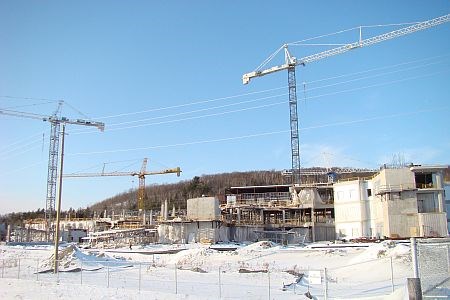Canadian consulting engineers are launching a study into the pros and cons of public-private construction projects (P3s).
A task force of the Association of Consulting Engineering Companies (ACEC) wants to present a professional guideline on the benefits and pitfalls of this construction delivery method.
“There are successes and horror stories and there's always a reason. It's not always the delivery model,” said chairman Francois Plourde, executive vice-president of CIMA + , a Laval, Que. civil engineering firm.
His task force is expected to deliver a report to ACEC members in November.
It's intended for members to make “intelligent and informed business decisions” participating in the P3 process and give sound advice to their clients, added John Gamble, president of Consulting Engineers of Ontario.
P3 projects are nothing new as a construction delivery model. Countries like the United Kingdom, Australia, France and Spain are far more advanced in using them with varying degrees of success and failure.
P3s have a long history in Alberta and British Columbia. California Governor Arnold Schwarzenegger said last March he wanted his state to copy the B.C. model used to build highways and hospitals.
Cash-strapped governments prefer P3s as an innovative financing scheme to tackle crumbling infrastructure and ensure that public facilities are built on time and on budget.
It's considered a way to spread the risk if projects run into delays or cost overruns.
These public-private partnerships gained prominence in Ontario when they were introduced by Infrastructure Ontario as a means to address skyrocketing construction cost overruns on hospital projects in Thunder Bay and Sudbury.
But these partnerships have many variations in the delivery models depending on the country, province and owners in terms of governance, risk transfer and procurement.
The study will examine project histories in different provinces in recent years, identify what went right or wrong, and hopefully identify some trends.
In a P3 concept, architects, engineers and builders no longer work for a building owner, but for a construction consortium.
The report will outline the pitfalls and benefits of different delivery modes and allow members to see what method suits them best.
It will give ACEC members some negotiating guidelines, especially if they're working as a sub-consultant for a large construction consortium in charge of these projects.
Although Ontario labour unions want government to stay clear of P3s as a means to finance, operate and maintain public facilities, Gamble said this model is here to stay.
“P3s are going to continue to be a fact of life in public sector delivery. We want to make sure we can help our members and their clients make informed business decisions in their participation in P3s.”
The task force will examine all the ways of delivering a project both by P3 and conventional means.
“When you look at the history of some cases as to why some went well and others not (so well), it's not because of the model, it's because you jumped over one step and you're in trouble,” said Plourde.
The lack of well-defined preliminary studies in engineering and procurement caused the costs of a Montreal-Laval transit line to more than double, he said.
Gamble expressed ambivalence toward P3 projects, so long as the risk is spread out.
“We want to see a fair and equitable beneficial relationship with the client where there's a reasonable allocation of risk and fair remuneration.”
Gamble said P3s offer “no magical formula” in construction delivery, which depends on the project and the client preferences.
“When you go through a P3 model, you're seeding a lot of control to the (construction) consortia in the final outcome. You're hoping you get what you want down the road and different owners have different levels of comfort.”
Quebec is re-analyzing where it's going with P3 projects by examining some of the flaws in its system.
The provincial agency in charge of P3s is attempting to pre-qualify contracts in different specialties since the collapse of a Laval highway overpass in 2006.
The investigating Johnson Commission found some contractors didn't have the skills and competence to build bridges. As well, the use of low-grade cement and the improper installation of rebar during construction contributed to the collapse that claimed five lives.
Quebec is re-jigging their criteria for selection by attempting to pre-qualify contractors for bridges, instead of restricting it to the lowest bidders.
Last December, Ontario's Auditor General Jim McCarter said the cost to build the Brampton Civic Hospital in 2001 would have been lower if the government had built the hospital itself, rather than use a P3 approach that contracted out certain non-clinical services over a 25-year period.
His value-for-money audit indicated a comparison of estimated costs of procurement between a P3 approach and a conventional one was not adequately done.
Gamble said there are many factors to consider in these complex projects. Value should be measured, not just on up-front costs in procurement, but on the long-term performance of a building.
“If you view engineering as a professional service, rather than a commodity, then you have a good recipe for seeing a successful project with a long-term valued sustainability, be it P3 or a conventional delivery project.”
www.acec.ca
www.ceo.on.ca




